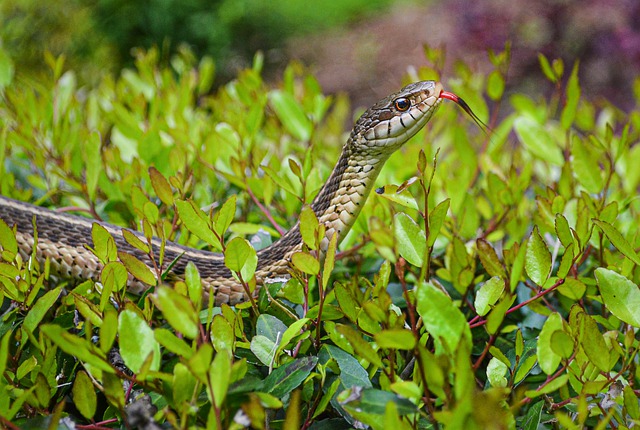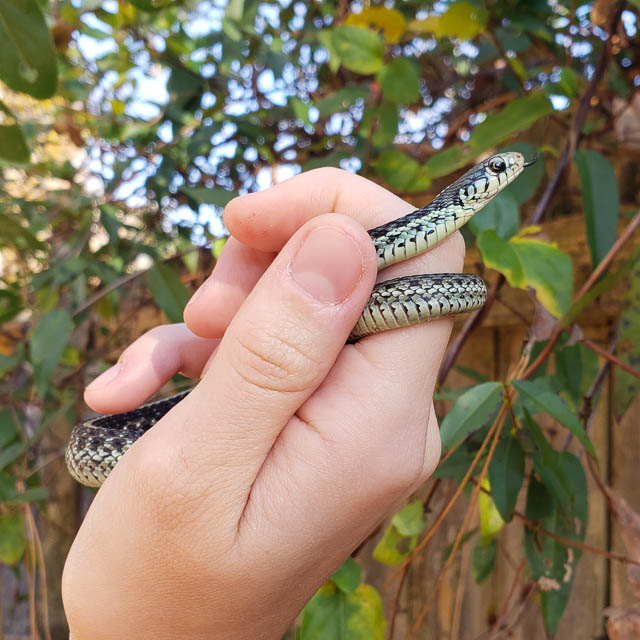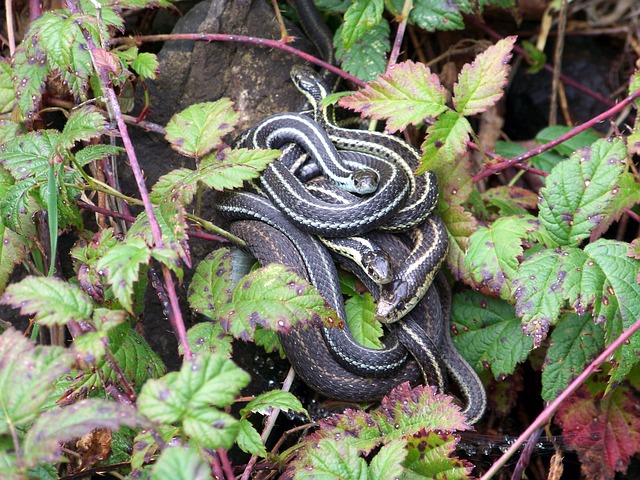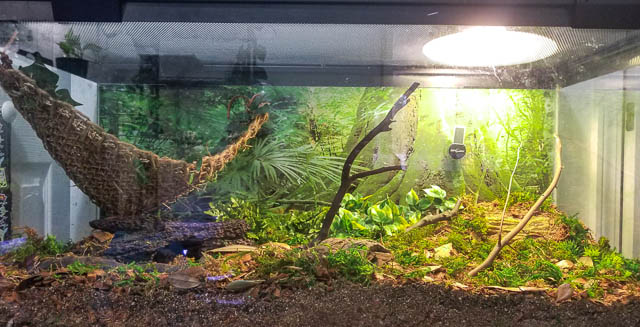Ultimate Garter Snake Care Sheet
January 5, 2022

Table of Contents
- Garter Snake Handling
- Feeding Your Garter Snake
- Garter Snake Enclosures
- Gater Snake Lighting, Heat, and Humidity
- Garter Snake Substrate
- Garter Snake Supplies
- Buying a Garter Snake
The Complete Guide to Garter Snake Care
Garter snakes are small, high energy snakes that make great pets for both beginners and experienced hobbyists. In captivity, garter snakes can live to be up to 10 years old, so you should take their long lifespan into consideration before taking the leap into ownership. Garter snakes typically grow to be between 23 and 30 inches long, however some individuals can reach up to 5 feet. Unlike many snake species, garter snakes are diurnal, meaning they are most active during the day, and tend to sleep at night. This is just one of the many reasons why garter snakes are an excellent choice for kids. Their overall care requirements are also extremely low maintenance when compared with other reptiles.
Garter Snake Handling
When you first bring home your garter snake it is important to place them directly into their enclosure and avoid handling them the first week while they get settled into their new environment. It is also important to note that during this time, they should be quarantined in a room far away from any other reptiles you may own while you monitor them. This is to prevent the spread of any sickness or mites that this new snake may have. To learn how to quarantine a new reptile, check out my article here. If you don’t own any other reptiles, there's no need to worry about quarantining them, however it is still a good idea to temporarily place them onto a paper towel substrate to monitor their droppings before transitioning them to a more natural looking substrate.
After the snake has had time to settle in, it is important to begin handling them so that they can get used to you. You can handle your snake once or twice weekly, but never more than once a day. Handling them too often can cause unnecessary stress. Remember, handling is for your enjoyment — not your snakes. Although most garter snakes are fairly docile snakes, if you attempt to pick them up in a way that mimics offering food they may become confused and bite you. Never yank your hand away from your garter snake if they do bite you. They have rear facing teeth, and therefore, pulling away can rip out their teeth, which can cause mouth rot. You should also avoid picking them up from above as it may frighten them. Predators tend to come from above, so it's best to gently reach for them from the side.
Note that some garter snake species, such as Florida Blues and California Red Sideds, tend to be more aggressive than others. Some species of garter snakes, including the Florida Blue, can also be mildly venomous. Unless you have an allergy, this venom is considered harmless and is no worse than a bee sting.

Feeding your Garter Snake
One of the many fun things about garter snakes is that they can eat a variety of foods. Baby garter snakes are typically started out on chopped up earthworms, and then transitioned to feeder guppies. It is extremely important to make sure the fish that you are feeding your garter snakes are guppies and not minnows or goldfish, as some fish have a potentially dangerous enzyme called Thiaminase that can be fatal to your snake. Ideally, once your garter snake is big enough, they should begin consuming pinky mice (or chopped up pinky mice). This is because mice have a higher nutritional value that will offer your garter snake a complete, well balanced diet. It can be difficult to provide the same nutritional value to your snake while only feeding them fish. However, once transitioned to a steady diet of mice, they can be supplemented with guppies on occasion if you’d like, but mice provide all the nutrients that they need. As they grow, they can be transitioned to fuzzies, and then hopper mice. Some larger adult females can grow big enough to need full grown mice. When in doubt of what size mouse is best for your garter snake, choose a mouse that is no larger than 1 ½ times the size of your snake’s body at its widest point.
You should always offer your garter snake pre-killed mice, not live ones. This is because a live mouse can injure your snake. When feeding your snake mice, it is important to do so using feeding tongs. This is to prevent your garter snake from accidentally grabbing your hands instead of the mouse. By feeding with tongs, you’re also ensuring that your garter snake won’t associate your fingers with food. Try to gently wiggle the mouse in front of your snake — this will mimic the movements of a live mouse, which will encourage your snake to eat. If you’re having difficulty switching your garter snakes over from fish to mice, try scenting the mouse in the fish tank water.
How to Defrost Frozen Mice for Garter Snakes
The first step in defrosting mice is to put the mouse into a ziplock bag and place it into a large bowl in the sink. Next, turn your water to the hottest setting and let the bowl fill up. The frozen mouse will cool the water down, each time this happens dump the cool water and replace it with hot water. The goal is to get the temperature of the mouse's head to the same temperature that a live mouse’s head would be (which is around 96°F - 100°F). You can accurately check the temperature of the mouse using a temp gun. I know this can be time consuming (the bigger the mouse, the longer it takes to defrost) but it's the most efficient way. You should NEVER microwave a mouse as they have been known to explode. Check out my step by step guide on defrosting frozen mice for a more detailed breakdown.
Garter Snake Enclosures
Garter snakes are very active snakes that love to climb and explore. Because of this, a full grown garter snake should be provided with a 29 gallon tank. When shopping for an enclosure it is essential to look for one that has a locking lid. This is because garter snakes are excellent escape artists. If you can’t find one that already has a locking lid, don’t worry, you can purchase lid clamps that will secure a screen lid to your tank. These are the clamps that I use, and they do a great job at securing screen lids in place. If you use clamps, be sure to always pull up on the lid after clamping it to make sure it is completely secure. Another key feature that I encourage you to look for is an enclosure with front opening doors. Having front opening doors is not a necessity, however it will make handling and feeding much easier since you can reach in from the side, preventing unnecessary stress.
Can Garter Snakes be Kept Together?
In the wild, garter snakes are a communal species (one of the few communal snake species) and therefore do well when kept in pairs or groups in captivity. Housing multiple garter snakes together means providing them with a larger enclosure. One garter snake per square foot is a good rule of thumb. If you choose to house multiple garters together you should make sure all of the snakes are roughly the same size. If one snake is larger than the other snake it will lead to the larger one consuming the smaller one. You should also separate them during feedings to prevent accidental cannibalism.

How Often Should I Clean my Garter Snake’s Enclosure?
You should check the enclosure for waste daily and spot clean when necessary. Once a month you should do a thorough deep cleaning of your garter snakes enclosure. During this deep cleaning you will want to remove all of the substrate and accessories. Check to see if the accessories are dishwasher safe, if they aren’t you can wash them with dawn dish soap. Be sure to rinse them well and allow them to dry completely. Clean the tank with a diluted bleach water solution, and be sure to thoroughly rinse the tank out and let it dry before adding fresh substrate and putting the accessories back.
Garter Snake Lighting, Heat, and Humidity
Garter snakes should be provided with a day and night cycle in captivity just as they would have in the wild. One way to do this is to place their enclosure by a window (but not where the sun will directly shine into the tank, this can cause the internal temperature of the tank to rise quickly). On top of being provided with natural lighting, your garter snake’s light should be on for 12 hours a day. UVB bulbs are not necessary for snakes like they are for some reptiles, however, there have been studies that show they can increase activity and make your snake’s colors brighter, and therefore I recommend using one. Don’t waste your money one “red lights” or “night lamps”. These are completely unnecessary and can actually disrupt your garter snake’s day and night cycle.
Garter snakes are cold blooded creatures, meaning they cannot control their body temperature and rely on their environment to warm them up. The ideal garter snake enclosure will have a cool side around 70°F and a warm side around 85°F. You should purchase two thermometers to go in your snake’s tank, one for the cool side, and one for the hot side. You will need to provide your garter snake with a heat lamp (or a ceramic heat emitter paired with a UVB bulb). The wattage bulb you will need will depend on the temperature of your home. The cooler your home, the higher the wattage you will need to create these temperatures — and vice versa. At night you may want to supply your garter snakes with a heat mat to prevent the temperature from dropping drastically. You will need to purchase a thermostat as well. Thermostats are used to regulate the temperature in your snake’s enclosure, preventing your snake from overheating or getting burned. NEVER use heat rocks. The heating mechanism in these is unreliable and uneven, and have been known to severely burn reptiles.
Garter snakes should have a constant humidity range between 40% - 60%. In order for them to have a complete shed, their humidity needs to be in the proper range. Too high of humidity can cause respiratory issues. You will need to place two hygrometers into their tank, one on the warm side and one on the cool side. These will help to give you an accurate reading of the ambient temperature and humidity throughout their enclosure. There are a few things that you can try if your humidity is too low or too high:
Humidity Too Low:
- Move the water dish under the heat lamp
- Use coconut husk as a bedding - it holds in humidity very well
- Cover ⅓ of the lid with tin foil or a damp towel (but if using a towel be sure to change it out and wash it often to prevent the growth of mold)
- Add moss to the enclosure
Humidity Too High:
- Move the water dish to the cool side of the enclosure
- Have a well ventilated enclosure (screen lids are good for ventilation)
Garter Snake Substrate
Substrate is what covers the floor of your garter snake’s enclosure. You may be wondering why what type of substrate you use matters, after all, the type of flooring we use in our homes usually doesn’t affect our well being. Reptile substrates are not all created equal, some are made for tropical reptiles and others are made with desert dwelling reptiles in mind. Other substrates can be extremely dangerous and should be avoided at all costs, despite what many commercial pet stores may try to tell you. So what is the best substrate for garter snakes? Well, thankfully you have a few options to choose from since garter snakes are a laid back species. Aspen is an excellent substrate choice for garter snakes. It's a fairly cheap substrate that can be found both online and in most pet stores. Aspen will help to provide your garter snake with enrichment as it gives them the option of burrowing. Coconut husk is another good choice, however it is pricier than aspen, and much more difficult to find in stores. NEVER house your garter snake on pine or cedar substrates. The oils that these substrates release are toxic to your snake. You should also avoid pebbles or gravel as substrate.
Garter Snake Supplies
Water
You should provide your garter snake with a water dish that is big enough to soak in. They love swimming, so oftentimes you may see them hanging out in or around their water dish, especially before they shed. I highly recommend looking into a heavy ceramic water dish. This will prevent your snake from burrowing under the water dish and getting crushed. This is the ceramic water dish that I use for almost all of my snakes. Another key thing to look for when getting a water dish is finding one that is dishwasher safe. This will make for a much easier deep cleaning, just make sure to rinse the dish out extra well before returning it to your garter snake’s enclosure. Make sure to routinely change out the water every couple days, and immediately change it if it is dirty.
Hides
Even though garter snakes are extremely outgoing snakes that love exploring their enclosure, they still need a dark place to curl up in and hide. You will need to supply your garter snake with at least two hides. One should be placed on the warm end, and the other on the cool end. This will allow your snake to comfortably move between temperature zones. Hides come in a huge variety of designs so you should have no issues finding some that are both fashionable for you and enjoyable for your snake. Just like with the water dish, it would be beneficial to find a hide that is dishwasher safe.
Decorating your Garter Snake’s Enclosure
Not only will decorating your snake’s enclosure make it look aesthetically pleasing, it will also provide your garter snake with security and enrichment. Many garter snakes love to climb, therefore adding branches and vines into your snake’s enclosure is a must. Always sanitize any branches you find outside before adding them to your garter snake’s enclosure. I have an in-depth article on how to sanitize branches for reptiles here. Not only is it exciting to watch your snake explore, this will also encourage exercise, which will help prevent your snake from becoming obese. Moss is another aesthetically pleasing addition to the enclosure. Moss provides your snake with natural smells and interesting textures, which in turn helps encourage enrichment. To learn more about how to add enrichment to your snake’s life, check out my article on enrichment!

Buying a Garter Snake
Where to Buy
If you’ve made it this far into the article, you are probably wondering to yourself “where can I buy a garter snake?”. Garter snakes are sometimes available in pet stores, though they are much less common to come across than corn snakes or ball pythons. I highly recommend checking out Morph Market. It’s a website full of passionate breeders, where you can find a better variety of morphs (colors and patterns). You will also have a better understanding of the background and genetics of the snake that you are purchasing since you’re going directly through the breeder. Be sure to read breeder reviews before buying a snake — some breeders are better than others. The downside of buying online is that you don’t get to check out the snake’s condition in person before making the purchase. We’ll go over that a little more in the “Finding a Healthy Garter Snake” section below.
Finding a Healthy Garter Snake
There are a few things to look for when picking out your garter snake. The first thing to look for is a snake with bright, alert eyes that is actively flicking its tongue. You’ll also want to check the snake for mites and ticks. These will be little back dots moving around on the snake and its substrate. Make sure the snake doesn’t have any loose skin and that its spine isn’t unnaturally defined — this can be a sign of dehydration or malnourishment. You should also check to make sure the snake doesn’t have any stuck shed on its body. Respiratory infections are common as well, so you should check the snakes breathing. If it is wheezing, clicking, or has bubbles coming out of its nose, there is a good chance that it has an infection. Note that with garter snakes, some clicking is normal as a result of how their glottis functions.
This post contains affiliate links that may pay me a commission when a sale is made. Affiliate commissions help me maintain this website, and I only recommend products that I trust.




Sending...